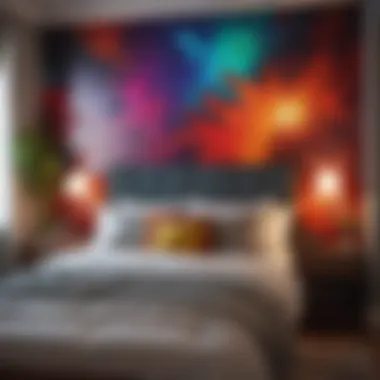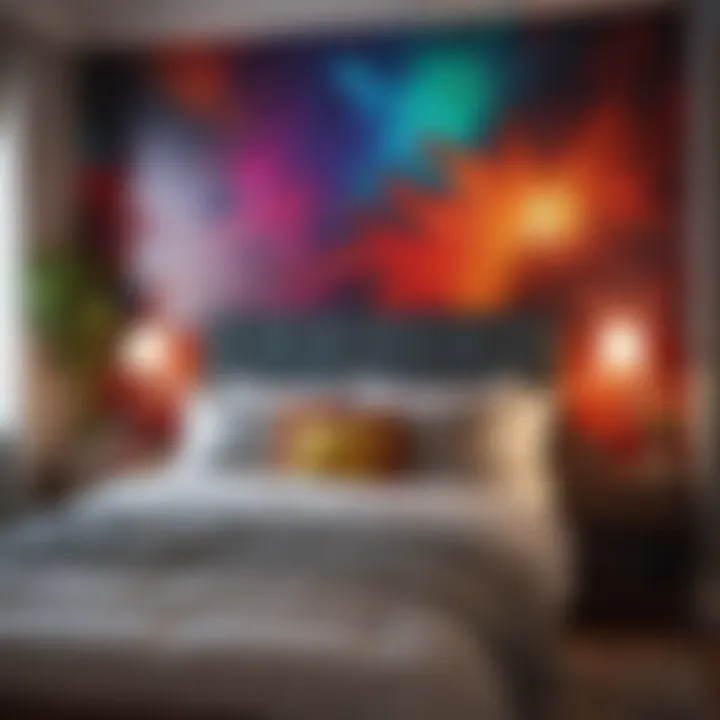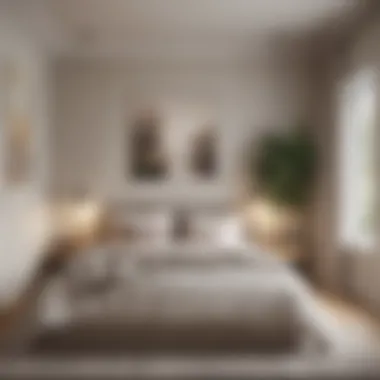The Role of Color in Enhancing Small Bedrooms


Intro
The color you choose for your bedroom can significantly affect how you feel in that space, especially in small bedrooms where every decision counts. Whether you want to evoke a sense of calm or create a cozy nest, color plays a key role. This impact is not just superficial; it delves deeper into the psychological responses we have to different hues. With the right color choice, small bedrooms can feel more expansive, inviting, and functional.
Each shade contributes to the overall vibe of the space. A light pastel can lift spirits, while a deeper, richer color can ground the design. This article is your roadmap, guiding you through the strategic use of colors to maximize the potential of your small bedroom. We'll discuss trendy design ideas, explore various color schemes and combinations, and delve into practical furniture arrangement techniques—all aimed at transforming your petite sanctuary into a visually appealing retreat.
Interior Design Tips
When it comes to small bedrooms, design choices need to be deliberate and well thought out. Here are some essential tips to help you harness the power of color effectively:
- Choose Light Colors for Walls: Light shades, such as soft whites, pale blues, or muted yellows, can give an illusion of more space. They reflect natural light, helping the room breathe a little easier.
- Accent Walls: Introducing a bolder color on one wall can create depth without overwhelming the space. Consider patterns or textures that draw the eye without constricting the visual field.
- Integrate Colorful Accessories: If painting isn't a viable option, colorful throws, rugs, and art pieces can breathe life into your room. They allow for easier changes if you're looking to refresh the look on a whim.
- Balance with Neutrals: A splash of color might catch the eye, but grounding it with neutral furniture and fixtures will keep the space feeling anchored and cohesive.
"Color is the keyboard, the eyes are the harmonies, the soul is the piano with many strings." - Wladimir V. L.
Trendy Design Ideas
Stay ahead of the curve with these fresh ideas:
- Earthy Tones: Colors like olive green and terracotta bring the outdoors in, creating a calm, natural vibe.
- Soft Pastels: Pale shades of pink and lavender can add warmth without being too overpowering, making them ideal for intimate spaces.
- Monochromatic Schemes: Sticking to one color in varying shades can create a sophisticated look while visually expanding the area.
Color Schemes and Combinations
Choosing the right color combinations can radically transform your bedroom's appearance. Here are some standout schemes:
- Cool and Calm: Blues and greens create a restful environment perfect for sleep.
- Bold and Bright: Vibrant colors like orange or magenta, when used sparingly, can inject personality and energy.
- Neutrals with Punch: Light neutrals mixed with a single, bright accent can elevate the design without making it feel cramped.
Furniture Arrangement Techniques
Strategic furniture arrangements can work wonders for small spaces. Here’s how to maximize your area:
- Place the Bed Against the Longest Wall: This can elongate the visual space and offer a natural focal point.
- Utilize Multi-Functional Furniture: Opt for pieces like a bed with storage drawers, allowing you to keep the room uncluttered.
- Incorporate Vertical Storage: Shelves and headboards that draw the eye upward can create the illusion of height, making the space feel airier.
As we draw this introduction to a close, remember that your bedroom is more than a place to sleep; it’s a reflection of you. Through careful color choices and strategic designs, you can craft a sanctuary that resonates with both style and serenity.
Understanding the Essence of Color in Interior Design
Color isn’t just decorative in the realm of interior design; it serves as a vital tool that can shape moods and influence perceptions, especially in small bedrooms where space feels limited. The essence of color goes beyond aesthetics. It embodies a psychological dimension that can create feelings of calm or chaos, warmth or coolness. Mastering how to use color effectively is essential for homeowners and interior enthusiasts looking to enhance their living spaces.
When it comes to small bedrooms, applying color thoughtfully can transform a cramped area into a comfortable retreat. The right hues can visually enlarge the space, create a sense of order, and tie together various design elements. Imagine stepping into a small room painted in soothing light blues or soft greens; these colors can evoke tranquility and a sense of openness.
Take a moment to consider these benefits of understanding the essence of color:
- Mood Enhancement: Different colors invoke different feelings. For instance, warm tones like yellows stimulate energy, while cool tones like blues promote relaxation.
- Visual Manipulation of Space: Lighter shades on walls can reflect light and create an illusion of depth, making your bedroom feel more expansive.
- Cohesion in Design: A well-thought-out color palette can connect various elements in a room, like furniture and accessories, leading to a harmonious look.
By grasping the fundamental role of color in interior design, one can make informed decisions that uplift not only the aesthetics but also the overall functionality of a small bedroom.
The Psychological Influence of Color
Color psychology delves into how different colors affect our feelings and behaviors. This aspect is crucial in designing small bedrooms, as the chosen colors can significantly impact daily moods. For example, warm colors like reds and oranges can stimulate action and excitement, while cooler hues, such as blues and greens, may promote a sense of peace and calm — ideal for a sleep environment.
A recent study showed that people around the world associate specific colors with emotions. Here’s a quick rundown:
- Red: Associated with energy, passion, and sometimes, anger.
- Blue: Often linked to tranquility and stability; it encourages a sense of peace, making it a favorite for bedrooms.
- Green: Symbolizes nature, life, and renewal, it’s refreshing and can soothe the mind.
- Yellow: A bright color reminiscent of sunshine and cheer, but too much can lead to agitation.
In a small bedroom, the psychological impacts of color can help create an environment that supports relaxation or invigoration, depending on individual needs and preferences.
Color Theory and Its Application
Color theory articulates the relationships between colors and explores how they can be combined to achieve stunning visual aesthetics. Understanding color theory is critical for homeowners and designers engaged in creating harmonious spaces. The color wheel serves as a fundamental tool in this exploration; it categorizes colors into primary, secondary, and tertiary groups, helping guide decisions when selecting a palette.
Moreover, color theory involves concepts such as:
- Analogous Colors: These colors sit next to each other on the wheel. Using these can create a serene and comfortable design.
- Complementary Colors: Colors opposite each other, when used together, produce a vibrant look that can energize a space.
- Monochromatic Schemes: This technique employs various shades of one color, allowing for depth with simplicity.
Applying color theory in small bedrooms ensures that the selected hues work together rather than fight for attention. Ultimately, combining theory with practicality enables a space to feel thought-out rather than haphazard.
"Color is the keyboard, the eyes are the harmonies, the senses are the symphony."
—Wassily Kandinsky
In summary, understanding the essence of color in interior design can empower individuals to mold their environments intentionally. By grasping the psychological influences and applying color theory, one can significantly enhance the quality of small bedroom spaces.
Small Bedrooms: Challenges and Opportunities


Small bedrooms pose their own unique blend of challenges and opportunities, especially when it comes to the impact of color. As living spaces shrink in urban areas, understanding how to effectively navigate these limitations becomes increasingly essential. Colors play a pivotal role in enhancing spatial perception and creating a desired atmosphere within these cozy confines.
Challenges include the risk of feeling cramped or cluttered. For instance, dark shades can make a small room feel even smaller. Conversely, choosing the wrong color combination can lead to a disjointed aesthetic, leaving the space feeling uncomfortable rather than inviting.
On the flip side, opportunities abound for creativity. A small bedroom offers a perfect canvas for experimenting with colors that evoke personal style and atmosphere. Correctly applied techniques can transform a confined area into a vibrant sanctuary. Utilizing lighter tones can open up the space, while specific accent colors can infuse life into the decor without overwhelming it.
In essence, approaching the challenges of a small bedroom with a thoughtful perspective on color can yield a rewarding and visually appealing outcome.
Maximizing Perceived Space Through Color
To maximize perceived space in a small bedroom, it’s crucial to be strategic about color selection. Light colors such as soft whites, pale blues, and gentle greens reflect more light than darker shades, making the room feel airy and expansive. Think of it like a trick of the eye; using lighter hues pulls the walls back, creating an illusion of greater space.
Additionally, consider utilizing a monochromatic color palette. By keeping the various shades within a single color family, you create a sense of harmony and continuity—which can visually extend the boundaries of the room. For instance, combining soft gray walls with slightly darker gray curtains can give a seamless look while still adding depth.
"It’s not only about color itself but how you use it to your advantage. A well-chosen color can create a world of difference in the size perception of your bedroom."
Balancing Light and Color
The relationship between color and light in a small bedroom is fundamental. Natural light can drastically alter how colors appear. What may look like a calming blue during the day might shift to a murky gray at night under artificial lighting. Homeowners should evaluate their space at different times of the day to see how light interacts with their chosen colors.
To strike a balance between light and color, one strategy is to combine colors with varying luminosities. For instance, pairing a soft yellow wall with brighter accessories can enhance the lightness of the space while adding pops of cheerful color. Alternatively, using color strategically around windows can maximize the natural light and create focal points that draw the eye.
Being mindful of lighting fixtures is another aspect to consider. Warmer lights contribute to a cozier feel, while cooler lights may amplify the effects of your chosen colors. Hence, it’s important to take both the presence of natural light and the quality of artificial light into account when selecting color schemes for your small bedroom.
Choosing the Right Color Palette for Small Bedrooms
Selecting the right color palette for a small bedroom is like choosing the right outfit before a big event. The colors you pick can affect not just how the room feels, but how it functions as well. A well-conceived palette can make the space feel larger, cozier, or even more energizing, depending on what you're after. This section serves as a guide through the nuanced layers of color choice, touching on benefits, considerations, and even the emotionality behind different hues. Finding harmony in a tiny space can truly transform it into a personal haven.
Neutral Hues: Classic and Versatile
Neutral hues have a perennial appeal in interior design, especially for small spaces. Colors like beige, gray, and soft white offer the ability to create a blank canvas. They're chameleons, easily complementing various decor styles from contemporary to classic. One of the key benefits of using neutral colors is their ability to make small bedrooms feel more expansive. The absence of visual clutter allows the eyes to travel around, creating an illusion of depth.
Moreover, neutral shades offer versatility. They're a solid backdrop for adding personal touches through textiles and decor items. Furniture in rich woods or bold accents like indigo or deep green stand out beautifully against a neutral palette, allowing for an intentional yet uncluttered aesthetic. For instance, if you choose a soft beige wall, you can create a striking contact point with a vibrant spread or an attention-grabbing headboard, letting those colors pop.
Soft Pastels: Subtle Serenity
Soft pastels, like gentle lavender, mint green, or light peach, evoke a sense of peace reminiscent of a spring morning. Pastels are particularly useful in small bedrooms since they offer softness without being overpowering. They have a unique way of reflecting light, which can help brighten the space, making it feel airy instead of confining.
When incorporating pastel shades, a bit of balance is essential. Too many pastel tones can lead to a washed-out feeling, while combining them with more robust colors can add depth. For example, pastel pink walls paired with a navy bedspread can create a lovely visual contrast, marrying softness with impact. The calm effect these colors provide is especially beneficial if one's sanctuary needs to promote relaxation and restfulness.
Bold Colors: Statement Choices
In a small bedroom, bold colors can often seem daunting—like walking a tightrope. That said, using vibrant shades intentionally can make a striking statement without overwhelming the space. Colors like deep teal, rich burgundy, or even a fiery orange can create dramatic focal points. The trick lies in knowing how to wield bold colors efficiently.
Consider creating an accent wall that showcases your chosen vivid hue while maintaining neutrality in other areas. A bold orange wall adorned with minimalist decor or framed artwork can serve both as a conversation starter and an anchor for the room. Additionally, bold colors can be particularly useful for creating zones in multi-functional spaces, guiding focus and intention.
"Choosing the right color palette can either make or break the mood of your small bedroom."
Creating Cohesion in Small Spaces
Creating cohesion within a small bedroom is not just about choosing a few nice colors. It involves a delicate balance between various elements, like furnishings, textiles, and accessories. Simply put, cohesive design pulls everything together, making a small space feel harmonious and inviting. When every piece in the room resonates with a common theme or color palette, it helps to create a sense of order and serenity. For a small bedroom, where every square inch counts, this is especially crucial.
Coordinating Colors with Furnishings
When you coordinate colors with furnishings, you're essentially creating a visual language that speaks to the overall design of the space. For instance, if your bedding is a soft shade of blue, matching it with curtains that carry the same hue can tie the room together nicely. Look for undertones that match; a warm beige couch paired with beige pillow cushions_ can enhance coziness_. It’s not just about mirroring colors; it’s about creating a flow that ties the space together.
Moreover, consider the scale and proportion of your furniture. Large, bulky pieces can be overwhelming in a small room, so choosing lighter colors or even slightly transparent materials can lighten the visual load. A sleek white dresser wouldn't just be a storage solution; it becomes part of the color story that complements your palette.
Using Accent Colors Effectively
Accent colors can act as the spice in your design recipe, providing pops of interest without overwhelming the senses. For small bedrooms, it’s important to select these sparingly. A deep navy blue accent wall might look spectacular against light grey tones, creating depth without closing in on the space.
You might consider using throw pillows, artwork, or a statement piece of décor to introduce an accent color. For example, if the room is predominantly white and grey, adding vibrant coral or teal accessories can bring energy into the space.
Using accents wisely creates contrast, adding vibrancy while maintaining cohesion. It's often a fantastic way to express personal style, because they can be easily swapped out as trends or preferences change.
"Less can be more in small spaces; the right accents can make all the difference!"
Light and Its Effect on Color Perception
Understanding how light impacts color is crucial when designing small bedrooms. You might think that color alone shapes a room's feel, but light plays a starring role. It sets the stage for how colors appear, interact with each other, and even how they affect your mood. Proper lighting can make a small bedroom feel airy or cozy, depending on the choices made.
Natural light is free and has an airy quality, creating a different vibe than artificial light. The sun’s rays bring warmth and can enhance color vibrancy. Unlike artificial lighting, natural light changes throughout the day. Particularly in smaller spaces, the play of light and shadow can create illusions of space. You can harness this by positioning mirrors to reflect light, thereby brightening the room and making it feel larger.


Natural Light vs. Artificial Light
To truly appreciate color in a small bedroom, you need to recognize the differences between natural light and artificial light sources. Natural light is often perceived as more flattering because it showcases colors accurately. It’s like a light sponge absorbing the beauty of what’s in your room. Hour-by-hour, the light changes—a soft dawn glow can make pastels pop, while the harsh midday sun can wash out deeper hues.
On the other hand, artificial light is your everyday companion. It comes with its quirks. Light bulbs, for instance, vary in warmth—some lean yellow, while others skew blue. This variation can make a beige hue seem drab or elevate it to a serene, inviting shade.
"Natural light and the right set up can make all the difference so your bedroom doesn’t fall flat."
Tips to consider when playing with natural vs. artificial light:
- Window Placement: Keep window coverings minimal to allow maximum light intake.
- Lighting Fixtures: Select bulbs that closely align with daylight, usually labeled as daylight or soft white.
- Decor Dynamics: Position mirrors across from sources of light.
Choosing the Right Lighting for Color Enhancement
When it comes to small bedrooms, good lighting enhances your color choices. Choosing the right lighting doesn't just brighten your space; it can elevate the mood. Think of it as your room's personality jacket.
Here are some pointers for picking lighting:
- Consider Bulb Type: Incandescent bulbs radiate warmth, while LED introduces a modern touch; test various types to see how they change your colors.
- Layer Up: Implement ambient, task, and accent lighting. This creates depth and highlights your decor elements.
- Dimmers: Install dimmer switches for a more adaptable experience. You can adjust the brightness depending on the time of day, creating the mood you want.
One powerful trick is to complement your wall color with light fixtures that feature a hue within a similar spectrum. For example, if your walls are a cool blue, selecting warm yellow light fixtures can create a harmonious effect, warming up the overall look.
Ultimately, in a small bedroom environment, harnessing the interplay of light and color effectively can shift perceptions, make the space inviting, and even shape the daily experiences of those who enter.
Trends in Small Bedroom Color Schemes
The colors we choose for our small bedrooms do more than just reflect our personal tastes; they shape our living experience. In understanding the trends in small bedroom color schemes, we recognize the influence these colors can have on mood, space perception, and ultimately, the very atmosphere of a bedroom. As more people embrace minimalism and eco-friendly lifestyles, color trends are evolving to meet these preferences. Consideration for trends is crucial, because following them allows homeowners and design enthusiasts alike to create spaces that feel fresh and thoughtfully designed.
As we dive into specific trends, we can see how they reflect both contemporary aesthetics and deeper emotional connections. With certain colors becoming more popular, they invite boldness or tranquility, depending on what you aim for in your small space. The following sections will take a look at nature-inspired tones and minimalist palettes for modern spaces, examining how these choices can enhance both style and functionality.
Nature-Inspired Tones
These tones are breathing life into bedrooms across the globe. Think along the lines of soft greens, sandy beiges, and rich earth tones. These colors are not only reminiscent of serene landscapes, but also tend to evoke a sense of calm and relaxation. When you incorporate hues that draw inspiration from nature, you create an environment that feels grounded and connected.
- What are the benefits?
Nature-inspired hues can make a room feel more open and airy, especially if you opt for lighter shades like soft sage or muted sky blue. They work well for small spaces by creating a visual connection to the outdoors. - Considerations:
One should be mindful of too many dark shades, as they can close in a room. Instead, mixing in light tones can create a beautiful balance. Using a light beige with darker green accents, for instance, can blend the earthy foundational colors with refreshing highlights.
"Colors remind me of my childhood, the sense of escape they provide. The greens of the trees, the blues of the sky," says a home design enthusiast on Reddit.
Minimalist Palettes for Modern Spaces
As we shift towards an era that values simplicity, minimalist palettes are increasingly gaining traction. These schemes often utilize a stark but beautiful contrast of black, white, and gray, sometimes punctuated with a single pop of color.
The minimalist approach, while seemingly straightforward, is about more than just keeping things tidy; it’s about creating a sanctuary that feels uncluttered and focused.
- Benefits:
A minimalist palette can give the illusion of more space, while resonating with a clean and sophisticated aesthetic. Small bedrooms can appear more organized, making room for creative arrangements of furnishings and decor. - Considerations:
Ruining this effect can happen if too many colors are introduced. Therefore, it’s a good idea to stick with a few select colors for walls, furniture, and bedding. A tip is to choose varying materials that catch the light differently, which adds dimension without overwhelming the visual space. Incorporating materials like soft linen or sleek metal can bring depth and subtle contrasts into a minimalist space.
In summary, trends in small bedroom color schemes reveal much about our design motivations and preferences. Nature-inspired tones offer serenity and connection with the environment, whereas minimalist palettes champion simplicity and elegance. The careful selection of color can empower homeowners to transform small spaces into personal retreats, blending functionality with individual style.
Practical Tips for Painting Small Bedrooms
When it comes to making the most of a small bedroom, color can be your best ally. However, applying paint isn’t just a matter of grabbing a brush and stepping to the canvas of your walls. Thoughtful strategies can make a world of difference in achieving the desired effect. Here, we’ll break down practical tips that can elevate your small bedroom, turning it from a cluttered afterthought into a stylish retreat.
Choosing Quality Paints
The foundation of any successful painting project begins with the choice of paint. Not all paints are created equal. When you pick up that bucket, funds are just one part of the equation. You also want to consider the finish—satin, semi-gloss, or matte can really shift the feel of the room. Satin paints tend to reflect light, which can help enhance space perception, while matte finishes can absorb light, adding coziness but possibly making the area feel more confined.
Additionally, think about paint quality. Low-quality paints might seem like a steal, but they can lead to problems down the line, such as peeling or fading color. When you go with respected brands like Sherwin-Williams or Benjamin Moore, you’re investing in longevity and aesthetic appeal. Look for zero-VOC options to maintain air quality.
Preparing the Space for Painting
Preparation is half the battle. Before you dive into painting, the workspace needs to be prepped meticulously. Here are key steps to make sure you’re ready:
- Clear out the room: Move furniture to the center, or better, to another room entirely if possible. This not only protects your valuables but gives you unencumbered access to all surfaces.
- Clean the walls: Dust and dirt can impact paint adhesion. A quick wash can prevent the frustration of peeling paint later on.
- Repair imperfections: Fill in holes, and spackle any dents. Smooth walls make for better finishes. Sand down any rough patches to ensure an even application.
- Tape it up: Use painter’s tape to protect trim and edges. This simple step can save hours of touch-up work and ensures those sharp lines that are nice to look at.
Techniques for Application
With everything prepped perfectly, you’re ready to get started. However, technique matters more than many realize. The way you apply paint can significantly affect the room's final look:
- Use a prime coat: If you’re changing from a dark color to something light or using a high-gloss finish, priming can make a world of difference. It looks better and may decrease the amount of paint needed.
- Employ brushes and rollers: Each tool has its strengths. Brushes are excellent for edges and detailed work, while rollers cover large areas quickly. A 9-inch roller is generally suitable for most small bedroom walls.
- Consider a paint sprayer: For those who are adventurous, a sprayer can achieve a smooth, professional finish, especially if you have intricate angles and tight spaces. Just practice first, as it comes with a learning curve.
"A little preparation and quality choices go a long way when it comes to both aesthetics and durability."


- Work systematically: Start from top to bottom. Corners first, then use a roller on large areas. Overlap your strokes slightly to prevent visible lines.
Each step in painting a small bedroom carries its own importance. Being aware of the quality of your materials, preparing the space adequately, and using proper techniques can all contribute to a finished look that not only makes the room seem larger but also reflects a careful consideration for aesthetics. While it may seem trivial, the impact of these choices can enhance both your living experience and the overall ambiance of your small bedroom.
How to Integrate Color Beyond Paint
In the realm of small bedroom design, one may often find themselves preoccupied with the immediate act of painting walls, but to think that is the only way to infuse color is to limit your creativity. Integrating color beyond just paint opens a world of options, allowing for a more layered and dynamic approach to decor. It’s about weaving color through various elements in the space, resulting in a harmonious and inviting atmosphere without the overpowering sensation that a single hue can sometimes create.
Textiles and Accessories
Textiles play a crucial role in setting the tone and mood of any room, especially in smaller spaces. Using colorful textiles is a fantastic way to add warmth and personality. From curtains to bedding, each element serves as a canvas for color that can be changed with the seasons or your mood.
- Curtains: Choose fabrics in bold tones or delicate patterns that echo your overall color scheme. A rich maroon or deep teal can elevate the room without the permanence of paint.
- Throw Pillows: They are the frosting on the cake of bedroom decor. Mix and match patterns and colors for a cozy, eclectic feel. Consider shades like mustard yellow or forest green to bring in an organic touch.
- Rugs: A well-placed rug can anchor the room. A bright geometric pattern or a soft pastel shade can draw the eye and unify the space.
By investing in quality textiles and swapping them out occasionally, you can transform the whole vibe of a small bedroom without repainting the walls.
Artwork and Decor Elements
When it comes to introducing color through artwork and decor, the possibilities are practically endless. Engaging visual pieces serve not only as decoration but also as focal points that can express personal style and evoke emotions.
- Wall Art: Opt for pieces that resonate with you. A bold abstract painting or a serene nature scene can capture attention. Consider using multiple small frames arranged in a gallery style to create interest.
- Decor Elements: Incorporate colorful vases, sculptures or even wall-mounted shelves. A splash of cobalt blue or vibrant orange can liven up dull corners. It’s about finding unique pieces that reflect your taste.
- Plants: Indoor greenery adds both texture and color. Vibrant pots or colorful planters can enhance the overall aesthetic while bringing life and airiness to the space.
"Color is a power which directly influences the soul." – Wassily Kandinsky
In smaller bedrooms, where space may feel constraining, employing color through textiles and decorative elements rather than solely relying on paint can create depth and character. By making choices that resonate, you teach your environment to communicate your story while maximizing both aesthetics and comfort.
Common Mistakes to Avoid When Choosing Colors
Choosing colors for small bedrooms can feel like walking a tightrope; one wrong step and the balance can throw everything off-kilter. Understanding the common mistakes that homeowners and interior design enthusiasts often make is crucial for transforming a small space into a cozy yet stylish sanctuary. Addressing these pitfalls can make a world of difference in how the space feels and functions. Here’s an exploration of two prominent mistakes that can detract from the overall aesthetic and livability of your small bedroom.
Ignoring the Lighting Conditions
Lighting conditions play a fundamental role in how colors appear and resonate within a space. Failing to consider this can lead to choices that clash with the intended atmosphere. Natural light varies throughout the day and has a strong influence on how hues are perceived. For instance, a soft blue might look serene in the morning sun but could morph into a dull shade as evening approaches.
Homeowners should take a close look at their windows and be aware of how much sunlight pours into their bedroom at different times. South-facing rooms usually bask in bright sunlight, allowing for more vibrant colors without making the room feel cramped, whereas north-facing rooms might benefit from lighter and warmer tones, which bring a touch of cheerfulness into the often cooler light.
In addition to natural light, the type of artificial lighting used—whether it’s warm, cool, or something in between—can cause colors to appear differently. Hence, it's wise to sample paint colors on the walls and observe them at various times of the day, under different lighting conditions.
Overwhelming with Dark Colors
It’s tempting to go for bold, dark colors in a small bedroom, believing it will create a rich atmosphere. However, this choice can often backfire, making a small space feel even more cramped. True, dark colors can provide a sense of elegance and intimacy, but they also absorb light. When used excessively, they might push the walls in closer, which is the opposite of what most homeowners are trying to achieve.
Instead of overwhelming the space with figurative shadows, consider balancing dark colors with lighter accents. For example:
- Accent walls: Paint one wall a dark shade to add depth, while keeping the remaining walls light to maintain an open feel.
- Decor elements: Incorporate dark colors through bedding, curtains, or art pieces instead of the wall itself.
By doing so, you create visual interest without sacrificing the spaciousness of the room.
"Choosing the right colors isn’t just about aesthetics; it’s about how those colors interact with light and the size of the space itself."
Understanding these common mistakes is essential for anyone looking to enhance their small bedroom. Paying attention to lighting and color saturation will not only help avoid feeling claustrophobic but also ensure a pleasing and personal touch to the decor.
Summarizing the Role of Color in Small Bedroom Design
Color plays a vital role in the design of small bedrooms, shaping both the physical space and the emotional atmosphere within. The right color can create an illusion of spaciousness, influence mood, and reflect personal style. In a small area, where every square foot counts, the selection of hues can enhance or detract from the intended ambiance.
Understanding color's impact goes beyond mere aesthetics. Consider how different shades can evoke specific feelings. For instance, soft blues and greens can induce a sense of calm and relaxation, whereas bright yellows can energize and uplift moods. A well-thought-out color palette is not just a design choice; it is a strategic tool for improving the overall living experience.
Reinforcing a Personal Style
Every individual has their own taste, and small bedrooms provide a blank canvas to express this unique personal style. Color is a powerful medium for this expression. By carefully selecting the right palettes, homeowners can reinforce their identity within their space. For example, a soothing lavender can complement minimalist decor or bring warmth to modern design, while a bold red can highlight eclectic tastes.
Here are a few tips to reinforce your personal style through color:
- Identify Your Aesthetic: Reflect on what styles resonate with you—are you drawn to modern, classic, or bohemian?
- Mix Colors Thoughtfully: Create a cohesive look by mixing colors that complement rather than compete with one another.
- Use Accents to Express: Sometimes, less is more. If you love bright colors but fear overwhelming the space, consider using them as accents in cushions, artwork, or small decor items.
Color choices not only beautify a small bedroom but also energize and calm its owner, proving that it is an essential aspect of personal sanctuary.
The Lasting Impact of Thoughtful Color Choices
Color choices in small bedrooms are indeed lasting. When a homeowner invests time in selecting the right hues, the effects ripple through the years, enhancing the quality of life in that space. It's about creating a sense of place that feels right and inviting, rather than just a collection of furniture against a backdrop.
Research has shown that thoughtful color application can lead to prolonged happiness and satisfaction with one’s living area.
If planning to live in a space long-term, making well-considered decisions stands invaluable. Here’s why:
- Mood Enhancement: Colors can significantly affect emotional well-being. A light, airy blue can contribute to relaxation, ensuring a good night's sleep.
- Value in Resale: When it’s time to move on, well-chosen colors can add value to a home. Potential buyers might be attracted to a property that feels warm and inviting.
- Adaptability: Colors such as muted tones transform effortlessly with changing decor styles. They allow for flexibility as trends evolve over time.
Ultimately, small bedrooms must be nurtured with color choices that elevate the experience of living within. It's a blend of personal expression and strategic thinking—a recipe for a space that speaks not just visually, but emotionally.







